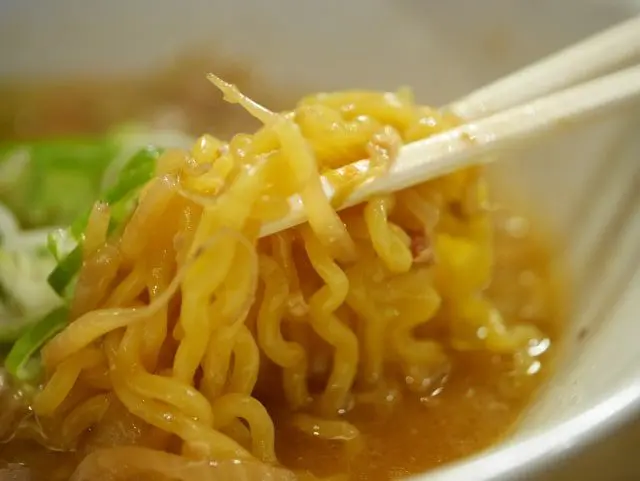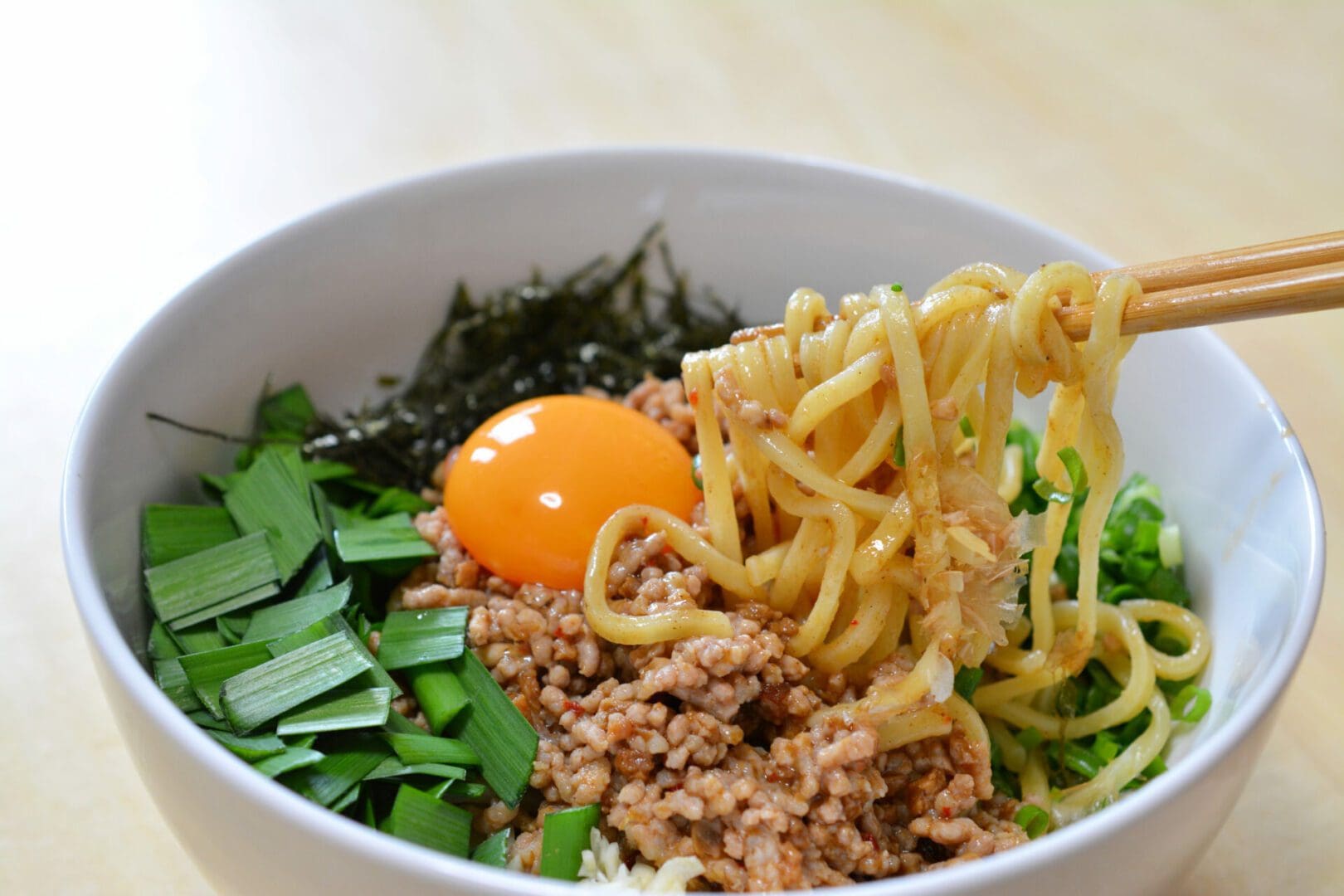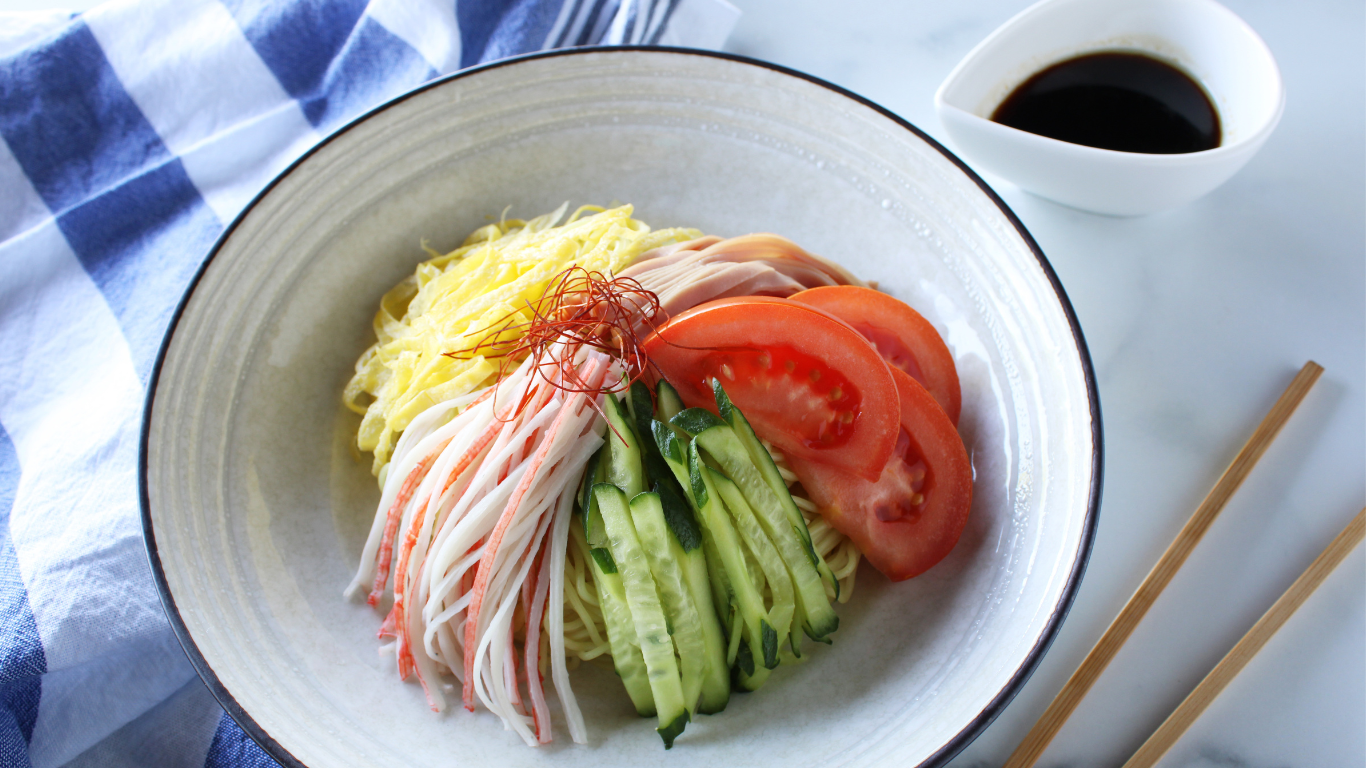Chow Mein vs Yakisoba: Differences between Chinese and Japanese Fried noodles
Published: Jun 20, 2022/ Last Updated:Mar 31, 2025
- 11 min read
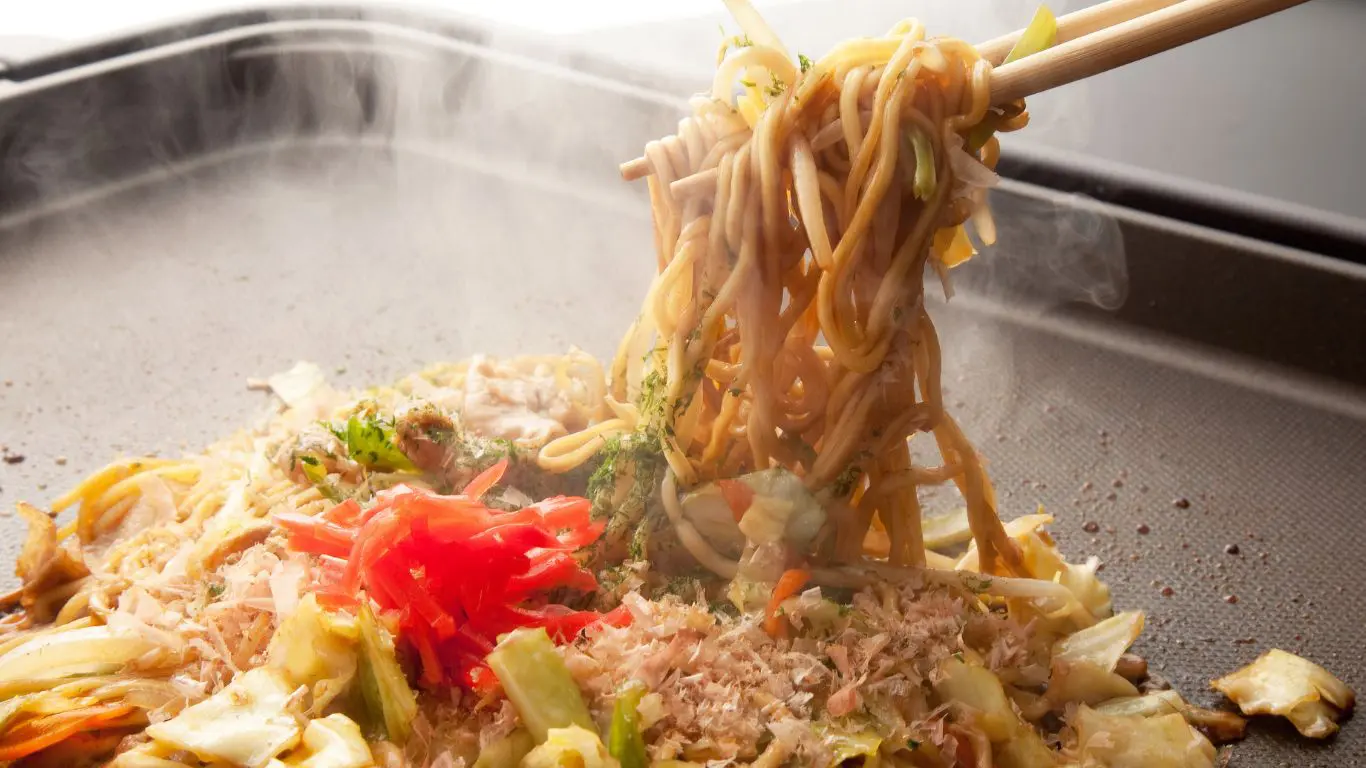
In the United States, Chow Mein is likely the dish that comes to mind when one hears, fried noodles. But there are many types of fried noodle options out there, and in Japan, Yakisoba is the most popular. Let’s dive into the differences between the two noodle dishes by starting with a deeper look at chow mein.
The history of chow mein is rooted in China’s Guangdong Province. The dish, Chaomian, was brought to the United States by Chinese immigrants during the Gold Rush and eventually became known as chow mein (炒麺). The character chow (炒) means “stir-fried” and the character mein (麺) means “noodles,” and, as the name suggests, the dish consists of Chinese noodles stir-fried with meat and vegetables. Two popular variations of the dish use alternate methods to cook the noodles. One calls for steamed noodles that are stir-fried with vegetables, meat, and other ingredients. The other method offers perfectly crispy noodles that are baked (or fried) in an iron pan and topped with thick potato-starch sauce and seasoned with salt or soy sauce.
As previously mentioned, chow mein was introduced to the United States through Chinese immigrants, and over time became a staple menu item at Chinese restaurants around the U.S. Its popularity is such that it would be difficult to find an American who hasn’t heard of it and/or tried it. Of course, in mainland China, there is a wide variety of fried noodle dishes, such as Shanghai fried noodles (flavored with Chinese tamari soy sauce) and Sichuan fried noodles (a spicy take on the dish), which goes to show the undeniable popularity of this dish.
Aside from the U.S., Chinese immigrants shared chow mein in other parts of the world, sparking more variations of the dish that are inspired by different regions and cultures. Some examples include Indonesian Mie Goreng, Singapore’s Hokkien Mee, and the Philippines’ Pancit Canton.
Let’s turn the page to our main topic of this post: Yakisoba. Another variation of chow mein, it is easy to connect the relationship that the Japanese dish has with the Chinese dish. For instance, yakisoba (焼きそば) includes the characters yaki (焼き) meaning “stir-fried” and soba (そば) meaning “noodles.” However, yakisoba has a unique characteristic that distinguishes it from other variations found in countries around the world, and that pertains to its seasoning. While other Asian countries pull from regional ingredients to season their fried noodles, offering a flavor that hits close to home (examples include sambal for hokkien mee, kecap manis for mie goreng, and oyster sauce for pancit canton), yakisoba is seasoned with Worcestershire sauce of British origin. Looking at the seasonings used in chow mein variations from other countries, the pattern would suggest that a typical Japanese seasoning be used, such as soy sauce. Oddly enough, that is not the case, and so the flavor of the popular Japanese fried noodle has a European twist.
This is how Yakisoba came to be in Japan. Its popularity with the Japanese people is especially evident at street food stalls, where it is often enjoyed. The dish has also won the championship title at the B-1 Grand Prix (a local gourmet food festival held in Japan) five out of eleven times in the past.
Although yakisoba has not yet gained the same level of recognition as chow mein, due to scarcity of restaurants that offer the dish in the U.S., its popularity is gradually spreading as fans are attracted to its distinctive sweet and spicy sauce flavor, also commonly used in okonomiyaki and takoyaki. Recently, instant and fresh yakisoba noodles have become readily available on the Internet, and their popularity is accelerating.
In this post, I would like to delve deeper into the various aspects of Japanese yakisoba, namely its origin, its characteristics and why it is gaining popularity in the United States. Whether you have enjoyed the unique noodles in the past or you are waiting for a chance to try them, this article will provide some interesting information that you are sure to appreciate.
- Index
- History of Yakisoba
- Characteristics of Yakisoba
- What are the “Three Greatest Yakisoba in Japan?
- Enjoy yakisoba at home!
- Advanced Recipe: Try “Yokote-style yakisoba”
- Conclusion
■History of Yakisoba
As mentioned at the beginning of this article, the history of Japanese yakisoba stems from Chinese chow mein. Chow mein spread from China to Japan by the Taisho period (1912-1926), but at the time, the dish was similar to mainland Chinese chow mein and consisted of soy sauce or salt seasoning, a stark contrast to the Worcestershire sauce flavor of today’s yakisoba.
So, when was Worcestershire sauce introduced into Japanese yakisoba? In the book titled, “Nippon Yoshoku Monogatari Taizen (にっぽん洋食物語大全)” by culinary researcher Keiko Kosuge, she writes that around 1935, an okonomiyaki restaurant in Asakusa, Tokyo served Asakusa Yakisoba, which utilized Worcestershire sauce for seasoning. It is worth mentioning that Worcestershire sauce, which originated in England, was not new to Japan in 1935. It first appeared in the country around the end of the 19th century, and by the beginning of the 20th century, it was popular nationwide to flavor okonomiyaki. Asakusa Yakisoba, or now known simply as yakisoba, was an inevitable marriage of Worcestershire sauce and fried noodles in Asakusa, Tokyo, a town at the forefront of fashion and innovation in 1935.
Thus, yakisoba was born, but its popularity didn’t reach past a few urban areas until after World War II. By then, the use of inexpensive cabbage as well as noodles made from flour obtained from the black market boosted yakisoba’s popularity at street stalls and quickly spread throughout the country. Incidentally, this style of yakisoba was born in Yokote City in Akita Prefecture, which still attracts many visitors from all over Japan as the birthplace of Yokote yakisoba, one of the three most popular yakisoba in Japan.
Furthermore, yakisoba can be cooked on a single griddle and the cooking procedure is simple, which is why it is often used in food stalls at summer and school festivals. As a result, the image that yakisoba is served at events and other special occasions, resonates with many Japanese people. That is the reason why the distinctive aroma of roasted sauce makes many Japanese people feel excited and nostalgic.
■Characteristics of Yakisoba
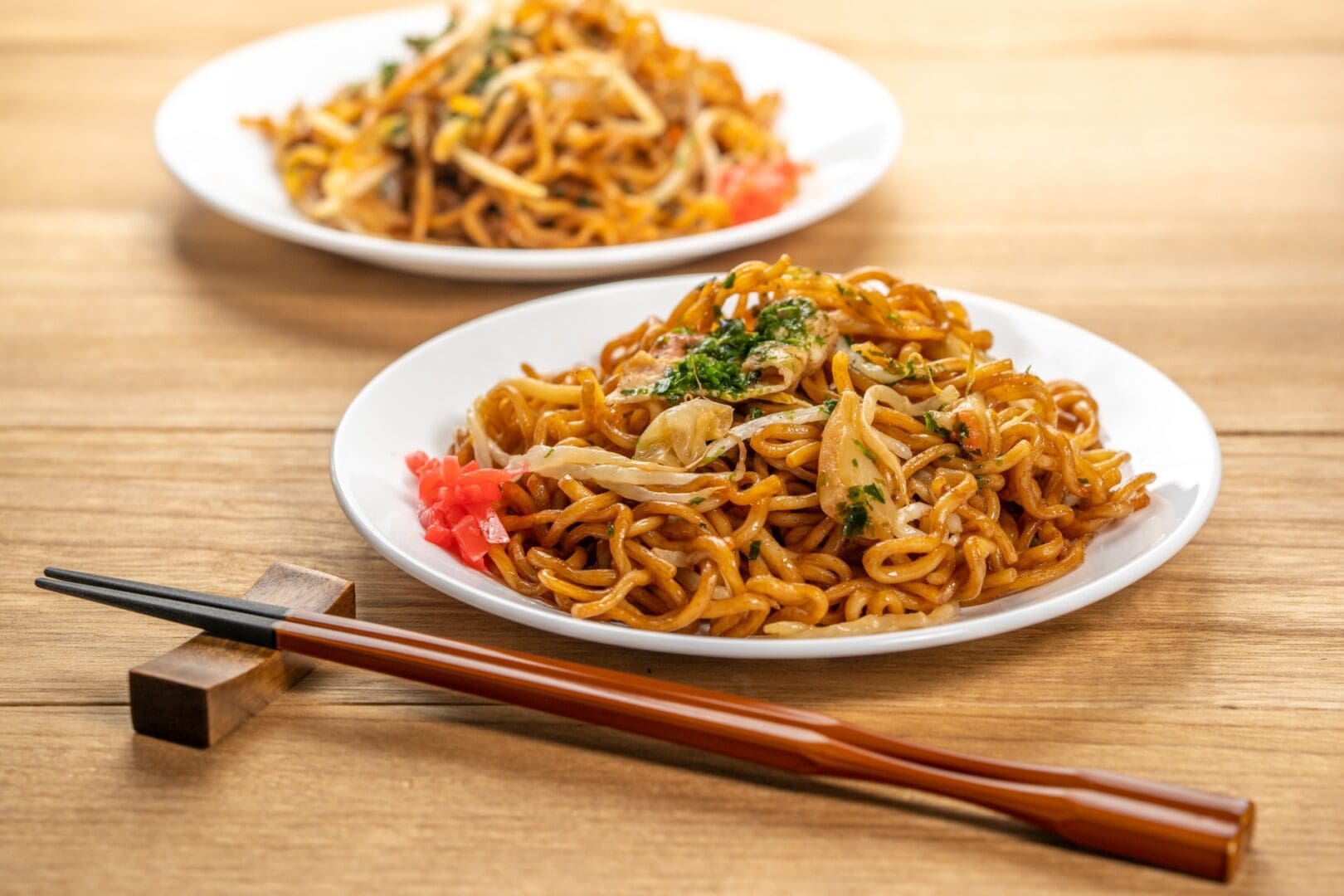
As mentioned in the previous section, one of the main characteristics of yakisoba is the use of Worcestershire sauce of English origin as a seasoning, even though the dish is based on chow mein imported from China. The slightly roasted aroma of the sauce poured over the stir-fried noodles, meat, and vegetables is attractive and mouth-watering, and has been proven in okonomiyaki and takoyaki as well. A variety of meat and vegetables are used in chow mein, but in yakisoba, pork is the meat of choice and cabbage, carrots, onions, bean sprouts, and green peppers are commonly used.
Other toppings that characterize yakisoba include aonori (dried green seaweed), shaved bonito flakes, and red pickled ginger (also used in tonkotsu ramen). Fried eggs and mayonnaise have also gained popularity in recent years as garnish.
In addition to the classic Worcestershire sauce flavor, other flavors such as Dashi-based “salt yakisoba,” “soy sauce yakisoba,” “miso yakisoba,” and “curry yakisoba” have emerged as popular variations of the dish, keeping with popular food trends.
To digress for a moment, those familiar with Japanese food may think that there is a connection between Japanese soba (蕎麦) and yakisoba, since the word “soba” is used in both. However, the noodles used for yakisoba are Chinese noodles, which are different from the buckwheat noodles used for Japanese soba. Another dish to look out for when dining at a Japanese restaurant is Gomoku Yakisoba (五目焼きそば), which includes “Yakisoba” in its name but is different from classic yakisoba. Gomoku yakisoba uses Chinese noodles, but the seasoning is not Worcestershire sauce, instead it’s a thick sauce made from potato starch, cooked meat, shrimp, carrots, bamboo shoots, shiitake mushrooms, etc. Please be aware of the difference between the two dishes if you are looking to order Worcestershire-sauce-flavored yakisoba at restaurants.
■What are the “Three Greatest Yakisoba in Japan?
Earlier we mentioned that Yokote City in Akita Prefecture is the birthplace of Yokote Yakisoba, one of the three most famous yakisoba in Japan. This means that there are two other famous “regional yakisoba” in Japan. In this section, the characteristics of each of the three major regional yakisoba in Japan will be introduced.

1. Yokote Yakisoba
First, let me better describe Yokote Yakisoba, the prototype of today’s Japanese yakisoba. As mentioned earlier, Yokote yakisoba originated in Yokote City, Akita Prefecture. It is seasoned with Worcestershire sauce with dashi (Japanese soup stock), which makes it slightly moist and sweet. It is also characterized by its use of cabbage and minced pork as ingredients, topped with a fried egg. The garnish is fukujinzuke pickles instead of the red pickled ginger that is commonly served with yakisoba. Yokote yakisoba is so popular among Japanese people that it has won a championship title at the B-1 Grand Prix (the local gourmet festival mentioned earlier) once and runner-up once, respectively.

2. Fujinomiya Yakisoba
This yakisoba is famous for promoting regional yakisoba throughout Japan. It originated in Fujinomiya City, Shizuoka Prefecture, where it has been enjoyed for many years, but since winning the championship in the first and second editions of the B-1 Grand Prix, the dish is well known nationwide. Its distinguishing characteristic is the firmness of the noodles, a satisfying treat. Other features include the use of niku-kasu (Pork back fat after squeezing out the lard) and sardine fish powder as ingredients. The unique flavor is addictive, and many people visit Fujinomiya City to enjoy the authentic taste.
3. Ota Yakisoba
Ota Yakisoba, the last of the three major yakisoba in Japan, is a regional yakisoba served in Ota City, Gunma Prefecture. Unlike the other three local yakisoba of this list, Ota yakisoba does not have a clearly defined characteristic in terms of seasoning or cooking method. Rather, the many variations of yakisoba offered at restaurants in the Ota area, each with its own twist on noodles and ingredients, make up the concept of Ota yakisoba. The website of the Jyoshu Ota Yakisoba Norenkai (上州太田焼そばのれん会), an organization of stores offering Ota Yakisoba, boasts that “no two are alike.”
In fact, there are many other fascinating regional yakisoba dishes in addition to the three major Japanese yakisoba mentioned above, but I would like to introduce only one of them in this article. It is Hiruzen yakisoba, which is served in the Hiruzen region of Maniwa City, Okayama Prefecture. This yakisoba is characterized with a rich, sweet and spicy flavor from a mix of Genghis Khan sauce and miso sauce. It’s popular with chicken and cabbage. In fact, Myojo USA’s PREMIUM SAVORY MISO YAKISOBA was developed as a nod to Hiruzen Yakisoba. Its appeal is different from regular yakisoba with Worcestershire sauce, so if you are interested in Hiruzen Yakisoba, please try it as well.
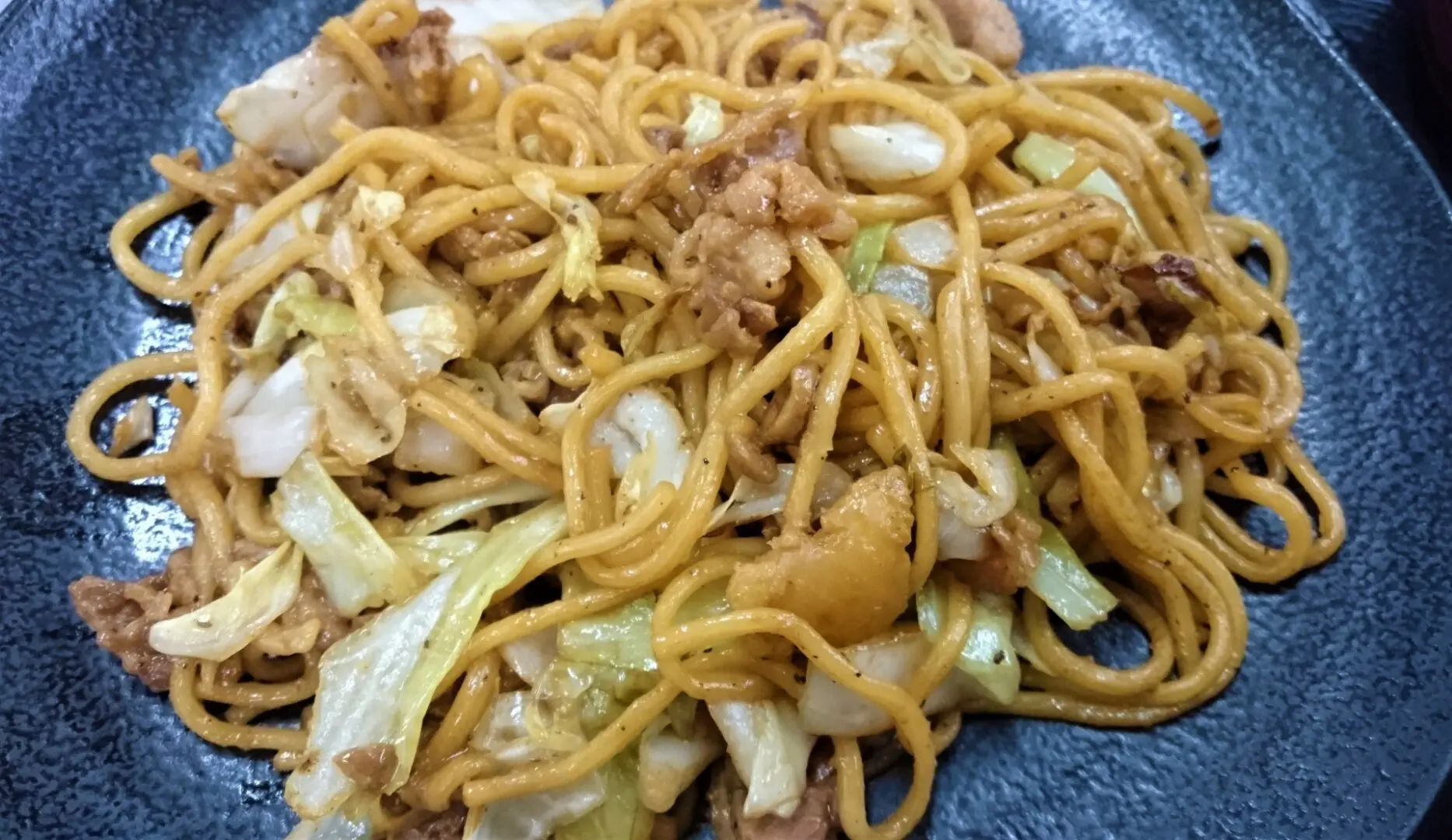
Additionally, if you would like to learn more about the Japanese regional yakisoba scene beyond the information presented here, please try a Google search for the keyword “ご当地焼きそば” in Japanese (it means “regional yakisoba”). You will surely be able to catch a glimpse of the profound world of regional yakisoba in Japan.
■Enjoy yakisoba at home!
The most common places in the United States to find Japanese-style yakisoba are Japanese restaurants and izakaya (Japanese-style pubs). You may also find yakisoba at some ramen shops and food courts of Japanese supermarkets. Perhaps outdoor events related to Japanese culture would exhibit food stalls serving yakisoba.
However, it is true that the environment in which people can casually order yakisoba is not yet widespread in the United States, so why not try making yakisoba at home? Yakisoba is a very simple dish that can be quickly prepared outdoors. All you need is your favorite meat and vegetables, sauce, and yakisoba noodles. For the meat and vegetables, get what you like at your local supermarket (vegetarians can skip the meat). As for the sauce and yakisoba noodles, you can count on Myojo USA! Cook up some authentic Japanese-style yakisoba at home with the following products.
Premium Yakisoba Series
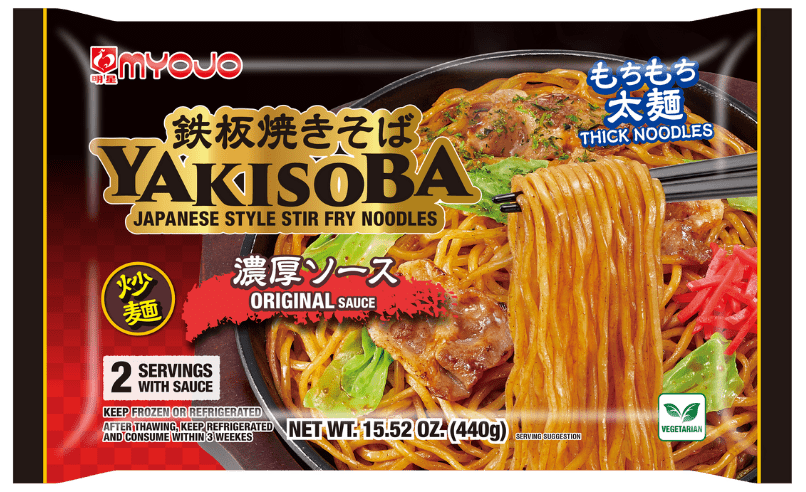
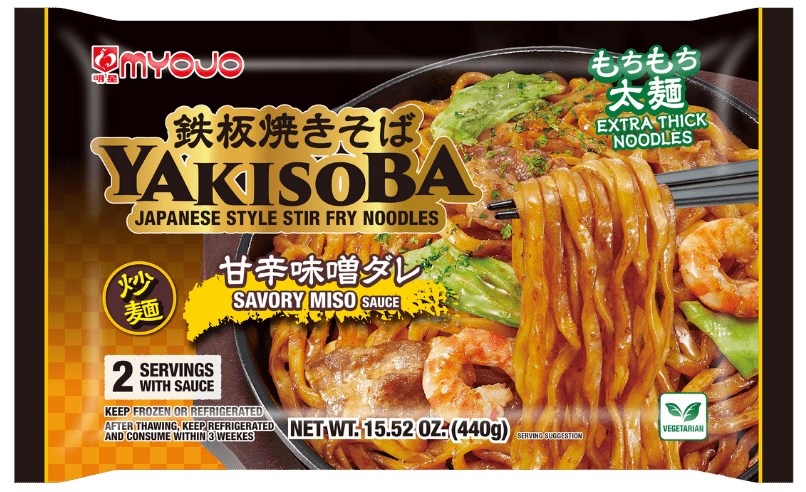
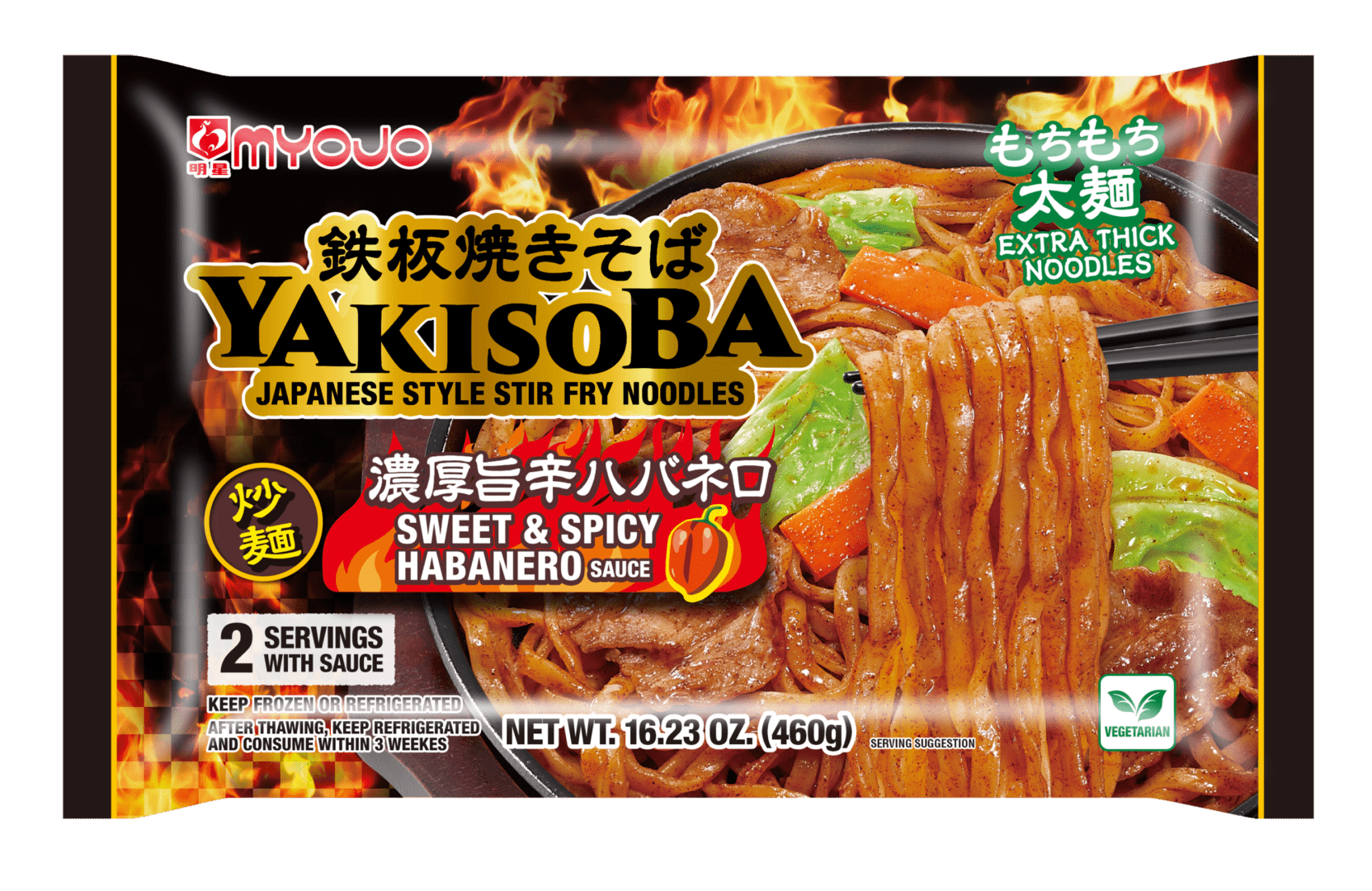
PREMIUM ORIGINAL YAKISOBA
https://www.myojousa.com/product/premium-original-yakisoba/
PREMIUM SAVORY MISO YAKISOBA
https://www.myojousa.com/product/premium-savory-miso-yakisoba/
PREMIUM SWEET & SPICY HABANERO YAKISOBA
https://www.myojousa.com/product/premium-spicy-habanero-yakisoba/
Features of Premium Yakisoba Series
- Thick noodles with chewy texture
- The noodles are served to the most suitable thickness according to the seasoning of the sauce
- Liquid type sauce with concentrated flavor
- 2 servings per package
Signature Yakisoba Series
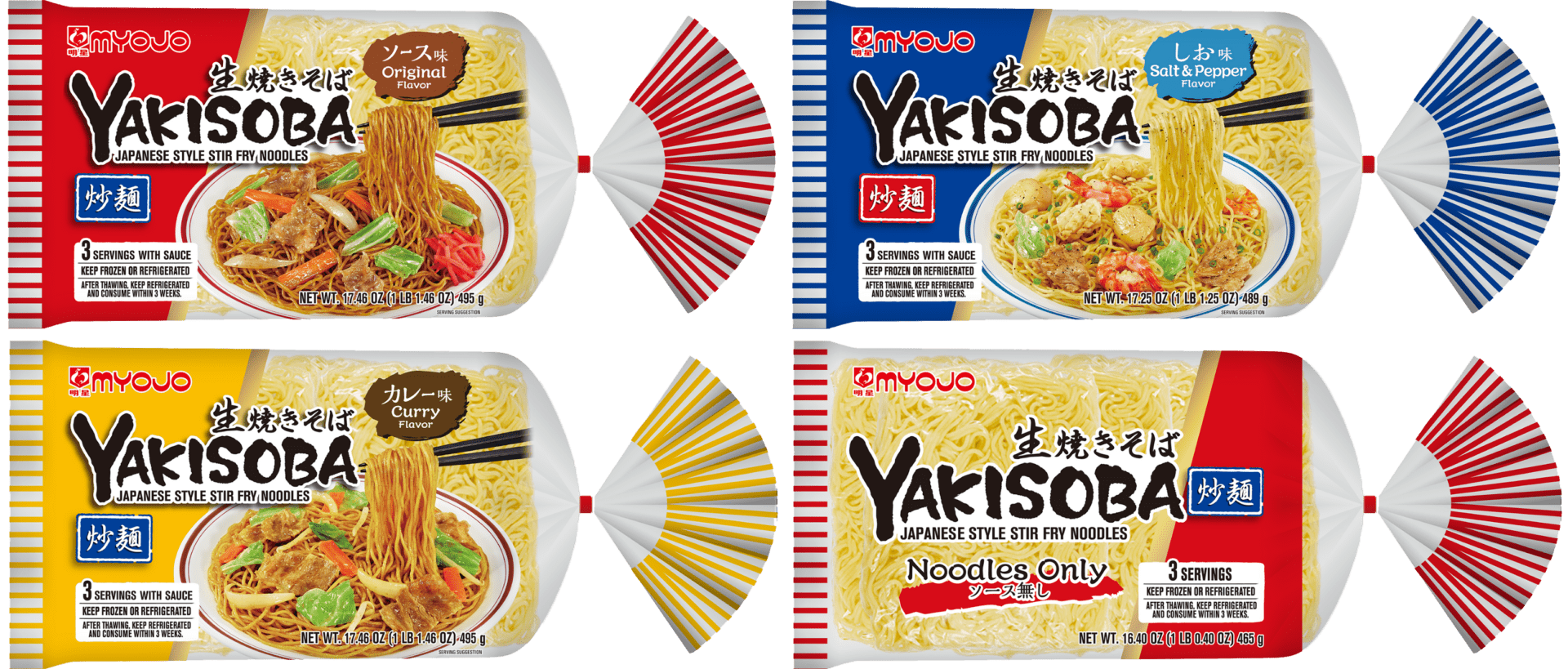
SIGNATURE ORIGINAL YAKISOBA
https://www.myojousa.com/product/signature-original-yakisoba/
SIGNATURE SALT & PEPPER YAKISOBA
https://www.myojousa.com/product/signature-salt-pepper-yakisoba/
SIGNATURE CURRY YAKISOBA
https://www.myojousa.com/product/signature-curry-yakisoba/
SIGNATURE YAKISOBA NOODLES ONLY
https://www.myojousa.com/product/signature-yakisoba-noodles-only/
Features of Signature Yakisoba Series
- Medium thin noodles with chewy texture
- Powder type sauce
- 3 servings per package
Ippei-chan
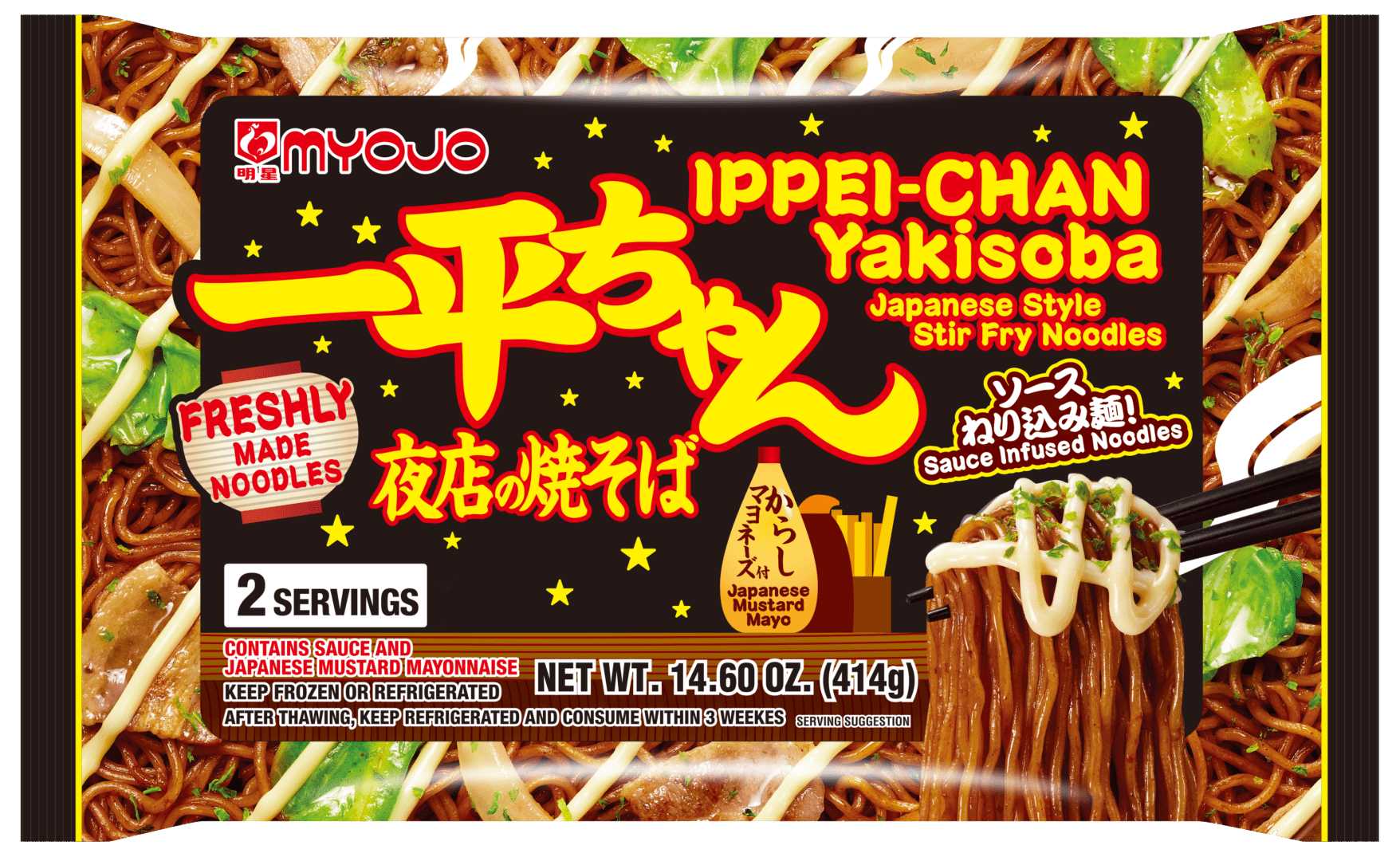
IPPEI-CHAN YAKISOBA
https://www.myojousa.com/product/ippei-chan-yakisoba/
Features of Signature Yakisoba Series
- Noodles infused with a secret sauce
- Smooth texture of fresh noodles (different from instant yakisoba)
- Specialty mustard mayonnaise for a unique flavor
As mentioned earlier, we offer a wide variety of yakisoba products for you to enjoy at home. Now, to make the authentic taste of fresh yakisoba even more convenient, we’re excited to introduce microwaveable yakisoba to our lineup!
Bowl Stir Fry Noodles
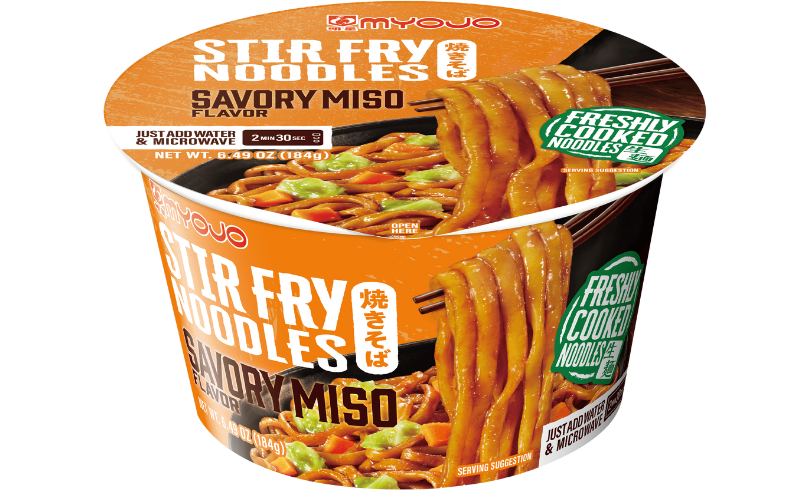
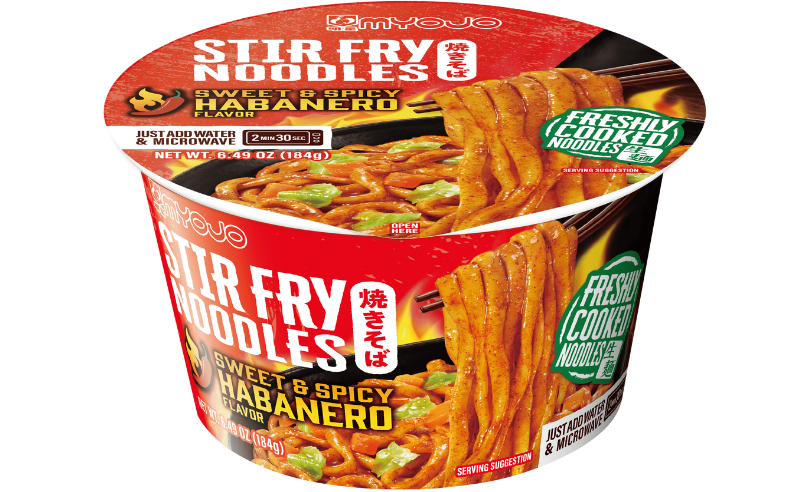
This product is completely hassle-free, making it the perfect choice for lunch at work or when you don’t have time to cook. Just put the noodles, seasoning and 2 tbsp of water into the cup, microwave for 2 minutes and 30 seconds, and it’s ready to enjoy! Unlike typical instant yakisoba, there’s no need to drain any water, making preparation even easier.
Despite its convenience, we haven’t compromised on taste. We use fresh-style noodles, ensuring an authentic texture that will satisfy even the most discerning food lovers. Available in two flavors: “SAVORY MISO” and “SPICY HABANERO”—choose your favorite!
Bag Yakisoba


Like BOWL STIR FRY NOODLES, this product can also be easily prepared in the microwave. However, it also offers the option of pan-frying, allowing you to customize your meal by adding ingredients like cabbage and green onions or searing the noodles for a richer flavor. If you enjoy personalizing your yakisoba, this is the perfect choice for you!
Flavors include “SAVORY MISO” and “SPICY HABANERO”, just like the BOWL STIR FRY NOODLES, so pick the one that suits your taste!
Here is where you can get Myojo Yakisoba.
https://www.myojousa.com/where-to-buy/
■Advanced Recipe: Try “Yokote-style yakisoba”
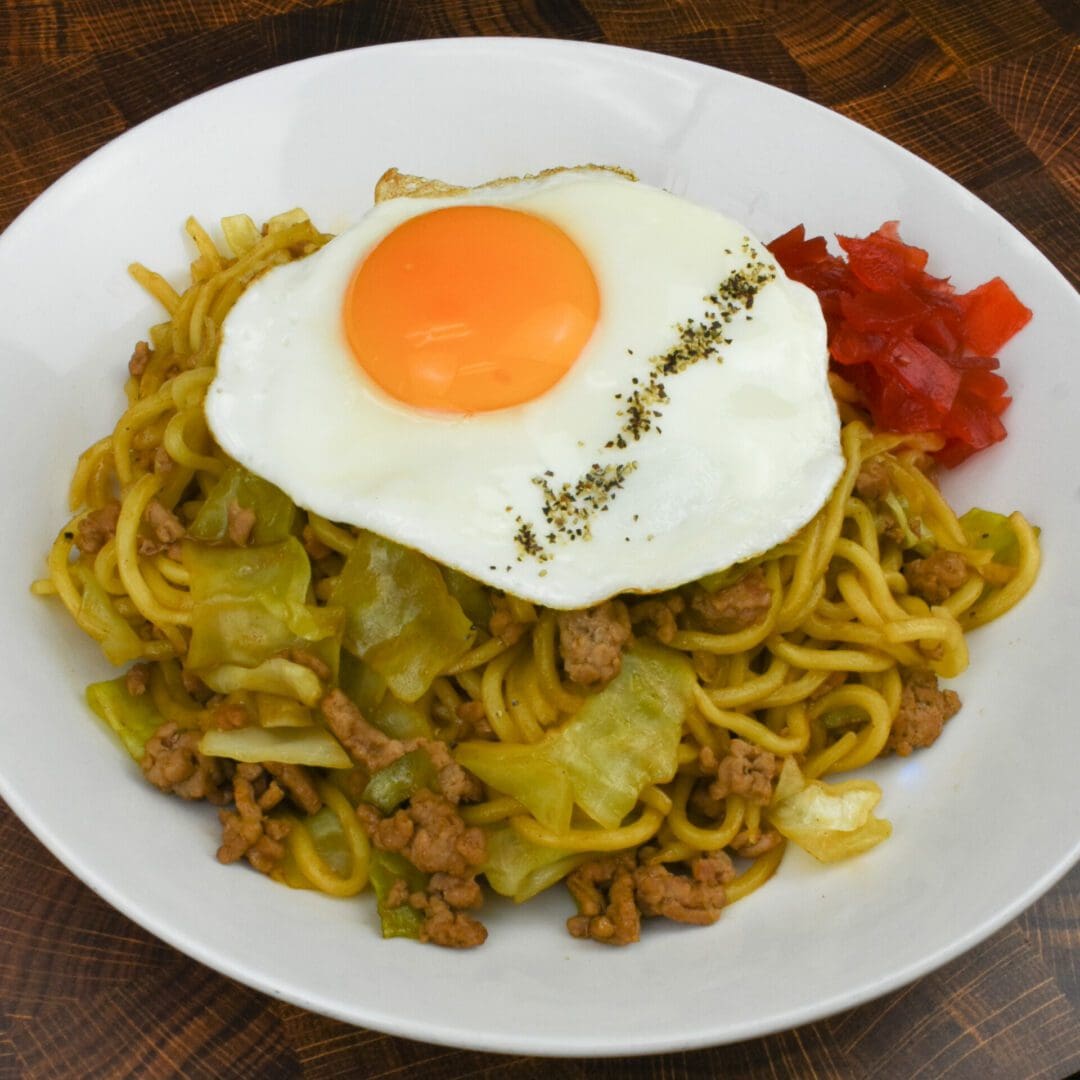
Once you have mastered regular yakisoba, we encourage you to try using Myojo USA’s yakisoba for a regional yakisoba-style flavor. This time, we will introduce a recipe for Yokote-style yakisoba, one of the three most popular regional yakisoba in Japan. The flavor that continues to captivate Japanese people may well break out in the U.S. in the near future, so be sure to keep an eye for it!
Recipe for Yokote-style yakisoba
https://www.myojousa.com/recipe/yokote-style-yakisoba/
*The recipe includes ingredients that are hard to find in the U.S., such as mentsuyu and mirin, but soy sauce can be a substitute for mentsuyu and sugar for mirin.
* Fukujinzuke pickles is only an option since it is a garnish, but if you want to recreate the authentic local flavor, do your best to get it.
■Conclusion
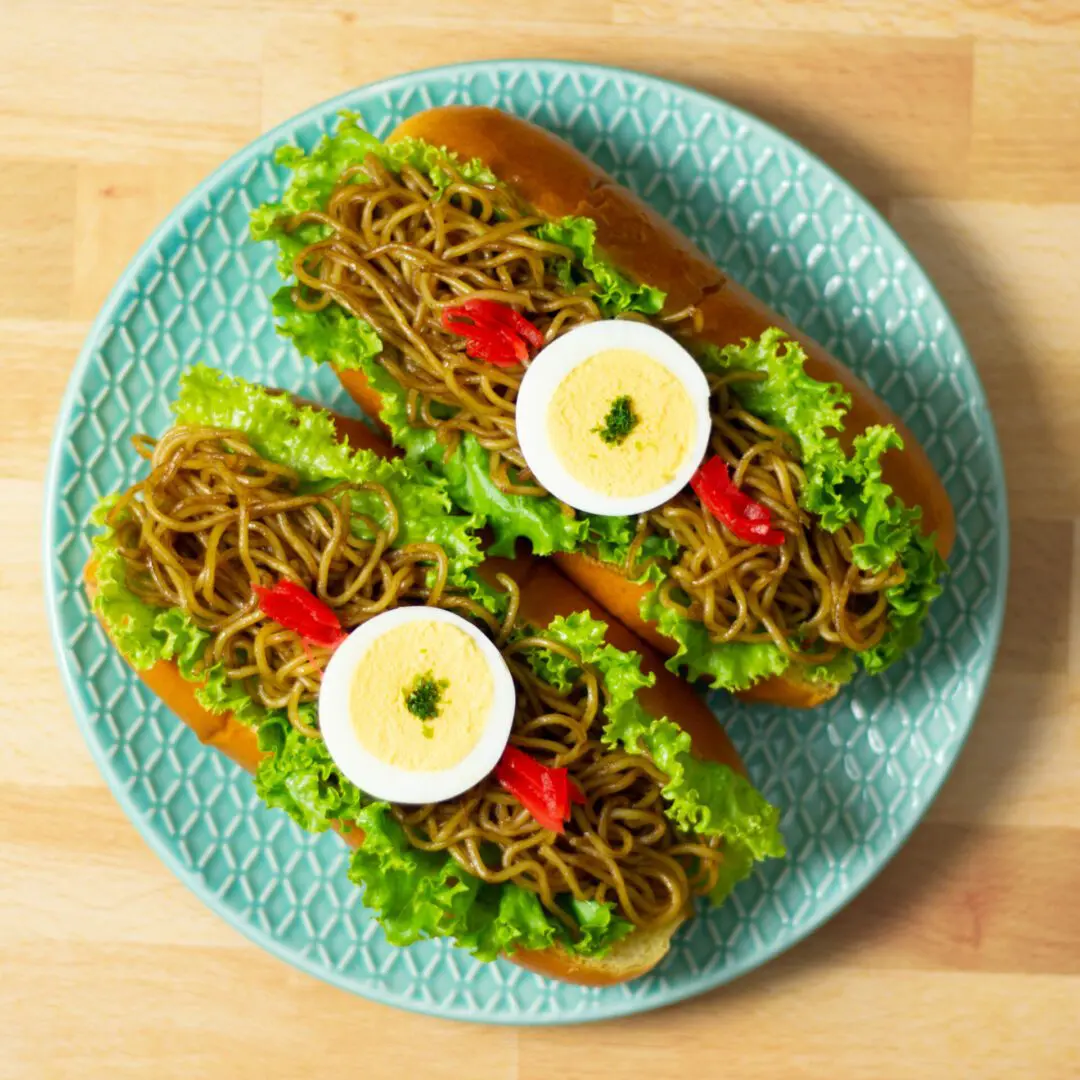
In this article, we introduced the unique characteristics of Japanese yakisoba. As mentioned in the text, yakisoba is a dish that is truly loved by the Japanese people. If you visit Japan, you will surely see yakisoba sold at almost every convenience store. Japanese people are very attached to Yakisoba, as is evident in the many unique uses of the dish, such as yakisoba-pan (a.k.a. Yakisoba Dog), omusoba (Japanese omelet with yakisoba), and soba-meshi (fried noodles & rice combined!). Furthermore, yakisoba is a staple of food stalls at summer festivals and outdoor events. From now until the end of summer, yakisoba stalls in Japan will exude the aroma of roasted savory sauces through crowds of people at summer outings. They will be sure to whet the appetites of many hungry people. If you happen to visit Japan during this season, you should try yakisoba from a yakisoba stall. Enjoying the dish outside adds to its distinct flavor and will make you fall in love with it instantly. And if you ever want to recreate that experience back in the U.S. (you know what I’m going to say, right?), try Myojo USA’s yakisoba!
Reference links:
焼きそば – Wikipedia
Chow mein – Wikipedia
Fried noodles – Wikipedia
ウスターソース – Wikipedia
焼きそばのルーツ『炒麺』とソース焼きそばのルーツ『浅草焼きそば』 – ニッポン放送 NEWS ONLINE
焼きそばをソースで味付けするのは日本だけ? | 横浜中華街世界チャンピオンの肉まん皇朝(こうちょう)
焼きそばブーム | 心の診療所 マルシェグループ
焼きそばの歴史・分類・ご当地焼きそば | ご当地グルメ研究所 – 楽天ブログ
焼きそばの発祥と由来はどこの国?日本と世界の代表焼き麺まとめ – めんおぶらいふ
第26回 焼きそばについて|みんな大好き日本の国民食を知ろう!!|食について学ぼう たべもの事典|グリコ栄養食品株式会社
国民食の裏には意外な歴史背景が!マニアが語る『焼きそば論』 – メシコレ
焼きそば文化 | 日本食品名産図鑑
日本三大焼きそばとは!? | ニッポン旅マガジン
横手やきそば – Wikipedia
横手やきそば暖簾会
富士宮やきそば学会 | 「B-1グランプリ」殿堂入りご当地グルメ
上州太田焼そばのれん会
ご当地グルメでまちおこしの祭典! B-1グランプリ
ホッケン・ミー – Wikipedia
ミーゴレン – Wikipedia
パンシット – Wikipedia
明星 一平ちゃんブランドサイト – 明星食品
